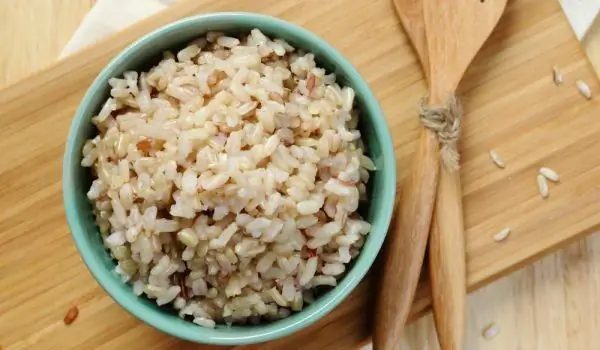2025 Author: Jasmine Walkman | [email protected]. Last modified: 2025-01-23 10:18
Although white and brown rice contain approximately the same amount of calories, brown rice has a number of benefits that are not bad to know. About 100 grams of it are enough for us to feel full, and the starch contained in it does not lead to the accumulation of fat. It also does not contain gluten, which is typical of almost all other cereals.
If you are a beginner in cooking rice, then choose a recipe that is made with brown rice. With it you have less chance of making a mistake, as it is easier to prepare than white and sticks in very rare cases. White rice, on the other hand, often sticks because it contains more starch.
The amount of rice we need for cooking is soaked in water and left to stand for at least 7-8 hours. It is drained and left to soak in cold water for another 15 minutes, then we leave it to drain for the same amount of time. In this variety of rice, soaking is extremely important, because otherwise cooking it will take you a long time.
Excluding the preliminary preparation, for the preparation of brown rice you need the same amount of water as for the white one, the best proportions should be 3: 1. The difference is that there are some special subtleties in the preparation of brown.
Put the rice in a bowl of cold water over very high heat. Add salt and cover with a lid. When it almost boils, remove the lid and reduce the heat to the lowest possible level.
Leave to cook for between 30 and 45 minutes (depending on the quality of the rice). Many people mistakenly take wild rice, which looks like brown rice, but it takes much longer to prepare.

Once the rice is cooked, turn off the heat and leave it covered for another 15 minutes to get a really fantastic rice. If you are going to prepare such a variety for the first time, keep in mind that its taste is quite different from that of white, so add more spices. You can boil it in a broth of your choice, and then add turmeric, curry or some other aromatic spice.
Recommended:
Grandma's Advice: Culinary Tricks And Subtleties In Cooking Soups

The taste of a soup depends on the raw materials used, its type and concentration. But last but not least, as the grandmothers say, it also depends on the skill of the cook. We can learn many of the intricacies of cooking from our grandmothers.
Culinary Tricks When Cooking With Garlic

Garlic gives a specific aroma and taste to a number of dishes, so here we offer you some tricks for cooking with it: - In order for the old garlic to smell less, we must remove the green sprout from the inside of the cloves; - We all know how annoying it is to stick flakes on the hands when peeling garlic.
Culinary Tricks In Cooking Beans

If we have to rank the Bulgarian dishes, then the beans will certainly be in one of the leading places. There is almost no home in which beans are not present at the table in various forms. No matter what season it is, beans are a dish that is always relevant and loved.
Culinary Tricks In Cooking Cabbage

Cabbage is one of the most valuable vegetables that have a beneficial effect on our stomach. Of course, if we want to get the most out of it, we must consume it properly, without overdoing it, because the rule that everything in moderation is allowed applies in full force when eating cabbage and dishes prepared with it.
Culinary Tricks When Cooking Onions

- We will be able to peel onions easily and quickly if we immerse them in warm water for a minute; - Water onion (sweet onion type Kaba), is used mainly for salads. Before we cut it, immerse it in cold water for five minutes and it will be tastier;

